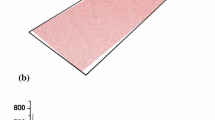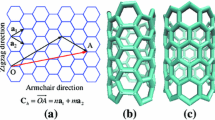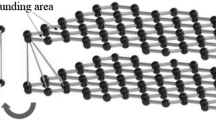Abstract
The present work investigates Young’s modulus of hexagonal monolayer sheets based on molecular mechanics. A repeating unit cell of the sheet has been chosen. Harmonic force field is adopted to model atomic interactions. The total energy of the unit cell is established as a function of the force constants and atomic displacements. A closed-form expression is formulated for Young’s modulus of the sheet by minimizing the total energy of the unit cell under uniaxial tension in equilibrium state. Molecular dynamics simulations were also carried out to consider Young’s modulus of graphene, boron nitride, silicon carbide, aluminum nitride, and boron antimonide monolayer sheets. The accuracy of the proposed formula is verified and discussed with results obtained by molecular dynamics simulations and available data in the literature for these 5 sheets.




Similar content being viewed by others
References
Andrew, R.C., Mapasha, R.E., Ukpong, A.M., Chetty, N.: Mechanical properties of graphene and boronitrene. Phys. Rev. B 85, 125428 (2012)
Arroyo, M., Belytschko, T.: An atomistic-based finite deformation membrane for single layer crystalline films. J. Mech. Phys. Solids 50, 1941–1977 (2002)
Arroyo, M., Belytschko, T.: Finite crystal elasticity of carbon nanotubes based on the exponential cauchy-born rule. Phys. Rev. B 69, 115415 (2004)
Baumeier, B., Krüger, P., Pollmann, J.: Structural, elastic, and electronic properties of SiC, BN, and BeO nanotubes. Phys. Rev. B 76, 085407 (2007)
Benkabou, F., Certier, M., Aourag, H.: Elastic Properties of Zinc-blende GaN, AlN and InN from Molecular Dynamics. Mol. Simul. 29, 201 (2003)
Berinskii, I.E., Borodich, F.M.: Elastic in-plane properties of 2D linearized models of graphene. Mech. Mater. 62, 60–68 (2013)
Berinskii, I.E., Krivtsov, A.M.: On using many-particle interatomic potentials to compute elastic properties of graphene and diamond. Mech. Solids 45, 815 (2010)
Boldrin, L., Scarpa, F., Chowdhury, R., Adhikari, S.: Effective mechanical properties of hexagonal boron nitride nanosheets. Nanotechnology 22, 505702 (2011)
Bosak, A., Serrano, J., Krisch, M., Watanabe, K., Taniguchi, T., Kanda, H.: Elasticity of hexagonal boron nitride: inelastic x-ray scattering measurements. Phys. Rev. B 73, 041402R (2006)
Brenner, D.W.: Empirical potential for hydrocarbons for use in simulating the chemical vapor deposition of diamond films. Phys. Rev. B 42(15), 9458 (1990)
Burkert, U., Allinger, N.L.: Molecular Mechanics. ACS Monograph 177. American Chemical Society, Washington, DC (1982)
Caillerie, D., Mourad, A., Raoult, A.: Discrete homogenization in graphene sheet modeling. J. Elast. 84, 33–68 (2006)
Chang, T.: A molecular based anisotropic shell model for single-walled carbon nanotubes. J. Mech. Phys. Solids 58, 1422–1433 (2010)
Chang, T., Gao, H.: Size-dependent elastic properties of a single-walled carbon nanotube via a molecular mechanics model. J. Mech. Phys. Solids 51, 1059–1074 (2003)
Cheng, Y., Shi, G.: The prediction of mechanical properties of graphene by molecular mechanics and structural mechanics method. Adv. Mater. Res. 583, 403–407 (2012)
Chopra, N.G., Zettl, A.: Measurement of the elastic modulus of a multi-wall boron nitride nanotube. Solid State Commun. 105(5), 297 (1998)
Claeyssens, F., Freeman, C.L., Allan, N.L., Sun, Y., Ashfold, M.N.R., Harding, J.H.: Growth of ZnO thin films-experiment and theory. J. Mater. Chem. 15, 139–148 (2005)
Cornell, W.D., Cieplak, P., Bayly, C.I., Gould, I.R., Merz, K.M., Ferguson, D.M., Spellmeyer, D.C., Fox, T., Caldwell, J.W., Kollman, P.A.: A second generation force field for the simulation of proteins, nucleic acids, and organic molecules. J. Am. Chem. Soc. 117, 5179–5197 (1995)
Erhart, P., Albe, K.: Analytical potential for atomistic simulations of silicon, carbon, and silicon carbide. Phys. Rev. B 71, 035211 (2005)
Golberg, D., Costa, P., Lourie, O., Mitome, M., Bai, X., Kurashima, K., Zhi, C., Tang, C., Bando, Y.: Direct force measurements and kinking under elastic deformation of individual multiwalled boron nitride nanotubes. Nano Lett. 7, 2146 (2007)
Hansson, A., Mota, F.B., Rivelino, R.: Metallic behavior in low-dimensional honeycomb SiB crystals: a first-principles prediction of atomic structure and electronic properties. Phys. Rev. B 86, 195416 (2012)
Hernández, E., Goze, C., Bernier, P., Rubio, A.: Elastic properties of C and BxCyNz composite nanotubes. Phys. Rev. Lett. 80, 4502 (1998)
Huang, Y., Wu, J., Hwang, K.C.: Thickness of graphene and single-wall carbon nanotubes. Phys. Rev. B 74, 245413 (2006)
Jiang, H., Zhang, P., Liu, B., Huang, Y., Geubelle, P.H., Gao, H., Hwang, K.C.: The effect of nanotube radius on the constitutive model for carbon nanotubes. Comput. Mater. Sci. 28, 429–442 (2003)
Jiang, L., Guo, W.: A molecular mechanics study on size-dependent elastic properties of single-walled boron nitride nanotubes. J. Mech. Phys. Solids 59, 1204–1213 (2011)
Kınacı, A., Haskins, J.B., Sevik, C., Cagın, T.: Thermal conductivity of BN-C nanostructures. Phys. Rev. B 86, 115410 (2012)
Kudin, K.N., Scuseria, G.E., Yakobson, B.I.: C2F, BN, and C nanoshell elasticity from ab initio computations. Phys. Rev. B 64, 235406 (2001)
Le, M.Q.: Atomistic study on the tensile properties of hexagonal AlN, BN, GaN, InN and SiC sheets. J. Comput. Theor. Nanosci. 11, 1458–1464 (2014a)
Le, M.Q.: Young’s modulus prediction of hexagonal nanosheets and nanotubes based on dimensional analysis and atomistic simulations. Meccanica 49(7), 1709–1719 (2014b)
Leach, A.R., Leach, A.R.: Molecular Modelling Principles and Applications, chap. 4, 2nd edn, p. 165. Prentice Hal, Harlow (2001)
Lee, C., Wei, X., Kysar, J.W., Hone, J.: Measurement of the elastic properties and intrinsic strength of monolayer graphene. Science 321(5887), 385 (2008)
Lei, X., Natsuki, T., Shi, J., Ni, Q.Q.: Analysis of carbon nanotubes on the mechanical properties at atomic scale. J. Nanomater. 2011, 1 (2011)
Li, C., Chou, T.W.: A structural mechanics approach for the analysis of carbon nanotubes. Int. J. Solids Struct. 40, 2487–2499 (2003)
Lin, S.S.: Light-emitting two-dimensional ultrathin silicon carbide. J. Phys. Chem. C 116, 3951 (2012)
Natsuki, T., Tantrakarn, K., Endo, M.: Prediction of elastic properties for single-walled carbon nanotubes. Carbon 42, 39–45 (2004)
Odegard, G.M., Gates, T.S., Nicholson, L.M., Wise, K.E.: Equivalent-continuum modeling of nano-structured materials. Compos. Sci. Technol. 62, 1869–1880 (2002)
Oh, E.S.: Elastic properties of boron-nitride nanotubes through the con- tinuum lattice approach. Mater. Lett. 64, 859 (2010)
Oh, E.S.: Elastic properties of various boron-nitride structures. Met. Mater. Int. 17, 21 (2011)
Pacilé, D., Meyer, J.C., Girit, Ç.Ö., Zettl, A.: The two-dimensional phase of boron nitride: few-atomic-layer sheets and suspended membranes. Appl. Phys. Lett. 92, 133107 (2008)
Pantano, A., Parks, D.M., Boyce, M.C.: Mechanics of deformation of single- and multi-wall carbon nanotubes. J. Mech. Phys. Solids 52, 789 (2004)
Peng, Q., Ji, W., De, S.: Mechanical properties of the hexagonal boron nitride monolayer: ab initio study. Comput. Mater. Sci. 56, 11 (2012)
Plimpton, S.J.: Fast parallel algorithms for short—range molecular dynamics. J. Comp. Phys. 117, 1 (1995)
Rappe, A.K., Casewit, C.J., Colwell, K.S., Goddard III, W.A., Skid, W.M.: UFF, A full periodic table force field for molecular mechanics and molecular dynamics simulations. J. Am. Chem. Soc. 114(25), 10024 (1992)
Rappe, A.K., Casewit, C.J.: Molecular Mechanics Across Chemistry. University Science Books, California (1997)
Reddy, C.D., Rajendran, S., Liew, K.M.: Equilibrium configuration and continuum elastic properties of finite sized graphene. Nanotechnology 17(3), 864–870 (2006)
Ru, C.Q.: Chirality-dependent mechanical behavior of carbon nanotubes based on an anisotropic elastic shell model. Math. Mech. Solids 14, 88–101 (2009)
Scarpa, F., Adhikari, S.: A mechanical equivalence for Poisson’s ratio and thickness of C–C bonds in single wall carbon nanotubes. J. Phys. D Appl. Phys. 41, 085306 (2008)
Sahin, H., Cahangirov, S., Topsakal, M., Bekaroglu, E., Akturk, E., Senger, R.T., Ciraci, S.: Monolayer honeycomb structures of group-IV elements and III-V binary compounds: first-principles calculations. Phys. Rev. B 80, 155453 (2009)
Scarpa, F., Adhikari, S., Phani, A.S.: Effective elastic mechanical properties of single layer graphene sheets. Nanotechnology 20, 065709 (2009)
Schneider, T., Stoll, E.: Molecular-dynamics study of a three-dimensional one-component model for distortive phase transitions. Phys. Rev. B 17(3), 1302–1322 (1978)
Shi, Y., Hamsen, C., Jia, X., Kim, K.K., Reina, A., Hofmann, M., Hsu, A.L., Zhang, K., Li, H., Juang, Z.Y., Dresselhaus, M.S., Li, L.J., Kong, J.: Synthesis of few-layer hexagonal boron nitride thin film by chemical vapor deposition. Nano Lett. 10, 4134 (2010)
Shokrieh, M.M., Rafiee, R.: Prediction of Young’s modulus of graphene sheets and carbon nanotubes using nanoscale continuum mechanics approach. Mater. Des. 31, 790–795 (2010)
Song, L., Ci, L., Lu, H., Sorokin, P.B., Jin, C., Ni, J., Kvashnin, A.G., Kvashnin, D.G., Lou, J., Yakobson, B.I., Ajayan, P.M.: Large scale growth and characterization of atomic hexagonal boron nitride layers. Nano Lett. 10, 3209 (2010)
Suryavanshi, A.P., Yu, M.F., Wen, J., Tang, C., Bando, Y.: Elastic modulus and resonance behavior of boron nitride nanotubes. Appl. Phys. Lett. 84, 2527 (2004)
Topsakal, M., Aktürk, E., Ciraci, S.: First-principles study of two- and one-dimensional honeycomb structures of boron nitride. Phys. Rev. B 79, 115442 (2009)
Tserpes, K.I., Papanikos, P.: Finite element modeling of single-walled carbon nanotubes. Compos. B 36, 468–477 (2005)
Tu, Z.C., Hu, X.: Elasticity and piezoelectricity of zinc oxide crystals, single layers, and possible single-walled nanotubes. Phys. Rev. B 74, 035434 (2006)
Tu, Z.C., Ou-Yang, Z.: Single-walled and multiwalled carbon nanotubes viewed as elastic tubes with the effective Young’s moduli dependent on layer number. Phys. Rev. B 65, 233407 (2002)
Verma, V., Jindal, V.K., Dharamvir, K.: Elastic moduli of a boron nitride nanotube. Nanotechnology 18, 435711 (2007)
Yakobson, B.I., Brabec, C.J., Bernholc, J.: Nanomechanics of carbon tubes: instabilities beyond linear response. Phys. Rev. Lett. 76(14), 2511 (1996)
Zhang, C.W.: First-principles study on electronic structures and magnetic properties of AlN nanosheets and nanoribbons. J. Appl. Phys. 111, 043702 (2012)
Zhang, H.W., Wang, J.B., Guo, X.: Predicting the elastic properties of single-walled carbon nanotubes. J. Mech. Phys. Solids 53, 1929–1950 (2005)
Zhang, P., Huang, Y., Geubelle, P.H.: The elastic modulus of single-wall carbon nanotubes: a continuum analysis incorporating interatomic potentials. Int. J. Solids Struct. 39, 3893–3906 (2002)
Zhao, J., Wang, L., Jiang, J.W., Wang, Z., Guo, W., Rabczuk, T.: A comparative study of two molecular mechanics models based on harmonic potentials. J. Appl. Phys. 113(6), 063509 (2013)
Zhou, X., Zhou, J., Ou-Yang, Z.: Strain energy and Young’s modulus of single-wall carbon nanotubes calculated from electronic energy-band theory. Phys. Rev. B 62(20), 13692 (2000)
Acknowledgments
This work was supported by Vietnam National Foundation for Science and Technology Development (NAFOSTED) under the grant number: 107.02–2014.03.
Author information
Authors and Affiliations
Corresponding author
Appendix
Appendix
Relationships between variations of bond length and angle with displacements of atoms
The bond length l ij can be determined by coordinates (x i, y i) of atoms i and (x j, y j) of atoms j as below:
Differentiating both sides of Eq. (18) gives:
It is noted that δx i = u i and δy i = v i are displacements of atom i in the x and y-directions, respectively. Equation (19) is rewritten as below:
At the initial state, we have l ij = l 0. Using Eq. (20) and regarding the conditions u 4 = u 5 = v 4 = v 5 = 0,δl 41 andδl 52 can be expressed by Eq. (7a) and (7b), respectively.
Regarding the geometric relations in Fig. 1c, we have
It is noted that sin (α 1/2 + δα) ≈ sin (α 1/2) + δα cos (α 1/2)for very small δα. Substituting Eq. (22) and (23) into Eq. (21) yields
Noting that α 1 = 1200, Eq. (7c) can be deduced by combining Eq. (7a) and (24). By conducting a similar analysis as above, Eq. (7d) can be also obtained.
Rights and permissions
About this article
Cite this article
Le, MQ. Prediction of Young’s modulus of hexagonal monolayer sheets based on molecular mechanics. Int J Mech Mater Des 11, 15–24 (2015). https://doi.org/10.1007/s10999-014-9271-0
Received:
Accepted:
Published:
Issue Date:
DOI: https://doi.org/10.1007/s10999-014-9271-0




